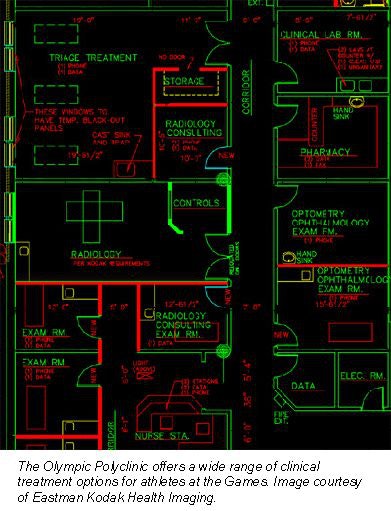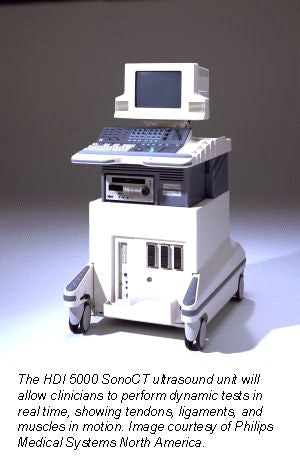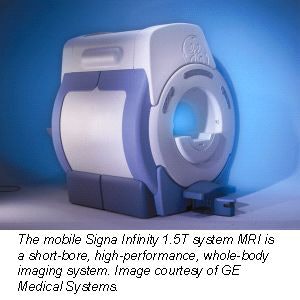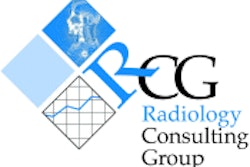

The Olympic Polyclinic has been outfitted with the latest in imaging equipment and comprehensive treatment options. The facility is staffed by top radiology professionals from across the U.S., who have volunteered time and expertise to treat Olympic athletes and their families.
"There are 10 radiologists, five radiology residents, 13 diagnostic technologists, and nine MR technologists who will be working at the Polyclinic during the Games. We will have at least one radiologist onsite from 7 a.m. to 11 p.m. each day," said Mary Freeh, Polyclinic radiology director and director of radiology for the University of Utah Hospitals and Clinics in Salt Lake City.
PACS
The medical imaging component of the Polyclinic boasts a cornucopia of equipment donated by leading imaging vendors. Image management of the facility is being handled by Eastman Kodak Health Imaging’s DirectView PACS, which ties together the clinic’s modalities, archive, printing, and offsite communications. The infrastructure layer of the network comprises more than 500 feet of 100Base-T Ethernet cable installed by Kodak engineers in the weeks leading up to the Games. For offsite transmission of images to the University of Utah for consultation, a dedicated fiber channel has been installed.
Images are routed from a Hewlett Packard LC2000 server configured for the DirectView workgroup server. The HP server, equipped with two Intel Pentium III processors and 2 GB of RAM, routes images to a pair of DirectView workstations. The workstations are built on an HP VL800 platform, and are equipped with a 1.4-GHz Pentium processor and 512 MB of RAM. The images will be viewed on a Dome Imaging Systems 3-megapixel 21-inch flat-panel portrait monitor at 1.5K x 1.5K resolution.
 |
Diagnostic reads and reports by attending radiologists will be assisted by Talk Technology’s TalkStationRadiology integrated speech recognition, dictation, and workflow software for radiology reporting, installed on each workstation. The company, a division of Agfa HealthCare, has supplied a representative who will be onsite for the duration of the Olympics to assist clinic personnel.
"It takes a few hours to train the system, so we plan to spend the first part of the radiologist’s first shift in this process and in their training on the PACS stations. With the assistance of the residents, I think most of the radiologists will be able to pick up and use the system quickly," Freeh said.
Archiving
Local image archiving is handled by a Kodak archive server, a Sun Microsystems 220 server with dual processors and 1 GB of RAM, which feeds images to a Storage Technology StorageTek L40 digital linear tape (DLT) library for long-term storage. For fast access to images, the system employs an EMC Clariion RAID system, which is also shared by the DirectView workgroup server. The RAID is composed of 10 73-GB drives, of which 511 GB is available for image storage based on using 7 of the 10 drives in the system. The total archive system capacity is 1 terabyte (TB).
"We use two of the drives for file backups, and one of the drives as a hot-swappable," said Bryron Mudd, Kodak technical representative. "All images on the RAID are stored at full fidelity, and are compressed at 2:1 using medical-optimized JPEG compression for storage on the Kodak archive. We use RAID level 5 archiving for full redundancy."
To ensure that there will be no interruption of service in the event of a power outage, each workstation is connected to an American Power Conversion (APC) PowerChute 650N uninterruptible power supply (UPS). The servers, archives, and all rack components are hooked to an independent APC 6kVA UPS.
Athletes at the clinic will be given copies of their images and reports via a Kodak 3600 desktop medical imager. The printer is capable of using both film and paper media up to 11 x 14 inches and A3 size, respectively, and has color and gray-scale capabilities.
"All radiology exams done at the clinic are read here. Our plan is to provide the report and some paper printed images for each patient to take with them when they leave," Freeh said.
Security
Assuring safety and security for the athletes, officials, administrators, and other representatives associated with the Olympics is a top priority. Stringent procedures, protocols, rules, and precautions have been put in place at all of the Olympics facilities, including the Polyclinic, to ensure the protection of everyone involved during the course of the Games.
In the interest of maintaining maximum security standards, Polyclinic representatives won't discuss details of the security plans. However, all individuals -- athletes, coaches, radiologists, physicians -- must be accredited through the Salt Lake Organizing Committee (SLOC) to gain access to the Polyclinic.
Each of the radiologists and physicians who have been authorized to access the Polyclinic must log on to a workstation via a Microsoft NT logon using a name and password. They must also log on to the Kodak imaging software with another password to access an athlete’s worklist and exams. If a radiologist leaves the workstation unattended for a specified period of time, the logon process must be repeated.
A comprehensive preparedness plan is in place to protect against disaster situations. While shying away from the details, Kodak representatives did say the plan includes provisions for onsite equipment backup, as well as for Kodak field engineers who will be onsite during the operating hours of the Polyclinic, and who will have access to systems and components if required.
Ultrasound
Philips Medical Systems is providing the Polyclinic with its HDI 5000 SonoCT ultrasound system. The system features real-time compound imaging, a process that maneuvers ultrasound beams "off axis" to achieve up to nine transmit angles in the course of a single ultrasound scan.
 |
The technology combines these multiple lines of sight in real time, allowing clinicians to acquire more diagnostic information than with conventional ultrasound imaging, according to the company. The system will also incorporate the company’s XRES (extreme resolution image processing) capabilities.
To develop XRES, Philips researchers conducted studies on the human eye’s ability to distinguish patterns in the different imaging modalities. Using some of the findings of this research, the company then created and applied an algorithm to ultrasound exams to improve clinicians’ ability to define tissue boundaries, extensions, and assess identifying characteristics.
XRES imaging analyzes individual pixel groups in real time to detect prevailing relationships and apply order, making it easier for the human eye to perceive tissue patterns needed to make the diagnosis. The resulting ultrasound images are then refined evenly throughout the entire field-of-view, according to the company.
A full range of broadband scanheads for the system is available for use by Polyclinic personnel during exams. Philips has also supplied one clinical support person and two technical support personnel for the system during the Games.
MRI
GE Medical Systems is providing the Polyclinic with its 1.5-tesla mobile Signa Infinity 1.5T system MR scanner for use during the Games. The system comprises a complete selection of coils, as well as a Kodak 8100 laser camera. The system can image in any orthogonal or oblique plane (including single- and double-axis obliques), using a wide variety of pulse sequences.
 |
The scanner is housed in a semi-trailer setup near the Polyclinic. The system includes a magnet and electronics that were installed in the trailer by the van manufacturer (AK Specialty Vehicles) and are fully calibrated by GE’s MR mobile manufacturing group.
A GE service team is onsite during the Games to ensure optimal system performance. After the Olympics, the van will go into the GE affordable rental (GEAR) pool of mobile systems, according to GE representative Linda Olsen.
Radiography
Radiographic images will be taken at the Polyclinic on a Kodak DR 9000 digital radiography system, which can produce review images in 10 seconds. The system is designed to perform a full range of diagnostic procedures, such as head, chest, skeletal, and extremity imaging, as well as trauma exams.
This is accomplished through the use of a ceiling-mounted multiplanar motion U-arm design. The U-arm permits the tube and bucky to rotate independently of each other, and allows the technologist to vary the source-to-image distance to accommodate a variety of radiology exams.
The DR 9000 features automatic image processing and an image cycle time of 35 seconds. In addition, through its connectivity to the DirectView PACS, patient demographics are integrated with the exam and the images are automatically routed to the DirectView workstations for reading by the Polyclinic’s radiologists.
Kodak is supplying the Games with intraoral and extraoral dental films, processing chemistry for film development, and Cook-Waite dental anesthetics, syringes, and accessories.
Offsite imaging capabilities
In addition to the comprehensive care offered at the Polyclinic, some of the Games sites will offer imaging capabilities to athletes.
GE has donated two OEC MiniView 6800 digital mobile C-arms that will reside at the Salt Lake Ice Center and the Peaks Ice Arena in Provo, UT -- the venues for ice hockey during the Games. The mini C-arms are real-time fluoroscopy systems that allow for visualization of fracture lines and bony anatomy.
 |
The C-arms will provide extremity imaging and feature 19-inch diagonal dual monitors for image viewing, 50-micron focal spot captures, and 1K x 1K 16-bit image processing. The venue protocol for each patient is a four-image study printed to film. Reference images will be distributed to team physicians or trainers, with a second set going to SLOC physicians.
GE also has a portable x-ray system at the University of Utah clinic in Park City, UT. This system is in close proximity to Olympic Park, where the luge, bobsled, and skeleton are run. It is also relatively near Deer Valley, UT, where the aerials, moguls, slalom, giant slalom, super G, and snowboarding events will take place. The University of Utah clinic in Park City as well as the Polyclinic are intermediary treatment facilities; any athletes with serious injuries will be airlifted to the Latter Day Saints (LDS) Hospital in Salt Lake City.
At the conclusion of the Games, the Paralympics Organizing Committee will take over the Olympic Polyclinic. Kodak will run and operate the equipment in the same capacity as the Olympic operations.
By Jonathan S. BatchelorAuntMinnie.com staff writer
February 8, 2002
The thumbnail image of the Olympic torchbearer is courtesy of Raymond J. Deininger.
Copyright © 2002 AuntMinnie.com



















